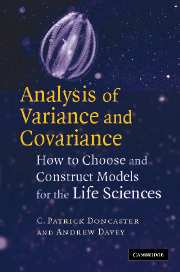Book contents
- Frontmatter
- Contents
- Preface
- Introduction to analysis of variance
- Introduction to model structures
- 1 One-factor designs
- 2 Nested designs
- 3 Fully replicated factorial designs
- 4 Randomised-block designs
- 5 Split-plot designs
- 6 Repeated-measures designs
- 7 Unreplicated designs
- Further Topics
- Choosing experimental designs
- How to request models in a statistics package
- Best practice in presentation of the design
- Troubleshooting problems during analysis
- Glossary
- References
- Index of all ANOVA models with up to three factors
- Index
- Categories of model
Best practice in presentation of the design
Published online by Cambridge University Press: 13 November 2009
- Frontmatter
- Contents
- Preface
- Introduction to analysis of variance
- Introduction to model structures
- 1 One-factor designs
- 2 Nested designs
- 3 Fully replicated factorial designs
- 4 Randomised-block designs
- 5 Split-plot designs
- 6 Repeated-measures designs
- 7 Unreplicated designs
- Further Topics
- Choosing experimental designs
- How to request models in a statistics package
- Best practice in presentation of the design
- Troubleshooting problems during analysis
- Glossary
- References
- Index of all ANOVA models with up to three factors
- Index
- Categories of model
Summary
How to report your designs and analyses
The objective of a Methods section to a report is to allow anyone to repeat all of your procedures. You therefore need to explain what you did and report all decisions relevant to the design of data collection and its analysis.
In the Methods, write out the statistical model either fully or in its contracted form (e.g., Y = B|A+ε). The residual variation should be indicated by e in a fully replicated model, to distinguish it from unreplicated or repeated-measures designs that do not have true residual variation. Clearly identify your sampling or observational unit, from which you draw each data point. Explain which factors are fixed and which random. Explain the function served by any random factors, and detail how these influence the construction of F-ratios. Where an analysis will not be testing for some interactions, explain why not. The reason is likely to have to do with intrinsic design features, for example of some split-plot and other non-orthogonal designs, or because of insufficient replication. That an interaction may be deemed biologically uninteresting is not a good reason for dropping it from the analysis, because to do so pools up the interaction with the error term and changes the estimates of the main effects.
- Type
- Chapter
- Information
- Analysis of Variance and CovarianceHow to Choose and Construct Models for the Life Sciences, pp. 260 - 263Publisher: Cambridge University PressPrint publication year: 2007



